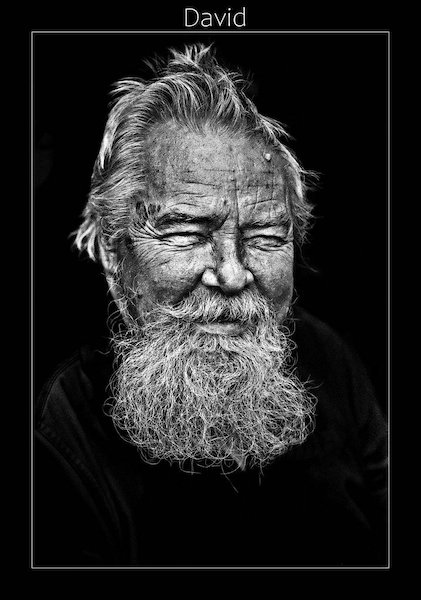Faces of the Last Good War
July 1, 2011
It’s a lovely day in Sonoma, CA. Willis Sanders—World War II veteran and photographer of the iconic 1952 shot of Ernest Hemingway aboard his boat Pilar in Cuba; Scotch drinker and recent widower—is offering his grandson, Tom, a few lighting tips before muscular degeneration and near blindness take over. Tom, as a teenager, likes to shoot portraits and visit his grandfather at the retirement community where Willis spends his days. Like most of his generation, he has little interest in his grandfather’s war service; in fact, it doesn’t “mean very much” to him at all.
It’s now 2006 and Tom is a senior at Cal Poly San Luis Obispo. He worries about typical things like girls and grades, and what to eat for dinner. Then one day he receives a portrait assignment at a neighboring retirement community where he meets World War II veteran Lt. Randall Harris. This man has battle stories that include shrapnel and unraveling intestines, and suddenly Tom has perspective. “When he was my age,” says Tom, “Randall was hoping and praying to live to the next day.”
In 2011, at only 26 years old, Tom now has more friends over 80 than you have of any age on Facebook. He has photographed over 400 veterans for his new book, The Last Good War: The Faces and Voices of World War II. Some of them you might even recognize—like Edith Shain, the nurse being kissed by a sailor in Times Square in what has now become one of the most famous photographs ever taken. Tom lamented her passing on June 23, 2010 at 93 years of age on his blog (www.tomsandersphoto.blogspot.com). It’s one of the hardest parts of his job—talking to someone on the phone and then a few weeks later learning of their death. “It’s always hard to hear,” he says. Or there’s Louie Zamperini, the famed prisoner of war and Olympic distance runner who once shook Hitler’s hand long before the fighting began. He and Tom live in adjacent California beach towns.
Still, friendships (and portraits of the elderly) don’t come easy. “Some of the veterans I photographed had severe Alzheimer’s or dementia,” Tom says. “I would say about 20 percent of them had some type of cognitive impairment. Oftentimes they’re in wheelchairs or had walkers. Sometimes I only had a minute with my subjects and had to get as much emotion out of them as I possibly could.” Patience is key, he says. With the elderly, “You have no choice.”
Perhaps even more challenging is what Tom calls the “begging” process, regarding the effort it takes to get guarded veterans to share their three or four stories. “World War II veterans do not look at themselves as heroes,” he says. “They looked at war as a job that needed to be done.” In spite of his book’s title, and the cultural phenomenon that understands World War II as a “good war” of unanimous support and unadulterated bravery, Tom acknowledges the difficulty of accessing the underbelly of a bygone time. “The veterans came of age in the Great Depression and had very little growing up. Then the country went to war as a whole. The ‘Greatest Generation’ is a tough group,” he says. “They are not complainers in any way. The vets don’t bring up any negative situations while discussing their experiences, except when referring to death.” Still, Tom concedes that he knows many still have nightmares. And there are even a handful of stories in his book that address racism that persisted long after the war ended. “There is a story about an African American (Carl E. Clark) who did not receive a medal for saving a ship until very recently because of his ethnicity,” Tom says.
While the book’s writer, Veronica Kavass, an interviewer with StoryCorps, is highly familiar with hearing and interpreting singular stories with linguistic prowess, thankfully there are, and will always be, the pictures to document what isn’t said. “The elderly have so much to teach us from their long lives of experience,” Tom says. “Their faces show their knowledge. Their wrinkles are like maps, showing every event of their lives.”
Of his recent 50-day book tour throughout 10 states, Tom says the road is both exhilarating and exhausting. “I spoke at bookstores, museums and on a Naval ship. I spoke to an audience of 300 at the National World War II Museum in New Orleans. I even got to go to Pearl Harbor.” Tom pauses a moment and then says something amusing. “Every once in a while a kid would come up to me and ask me about my book. It made me feel so good that I was connecting with the youth and making them more aware of their past.”
It was just three years ago that 23-year-old Tom Sanders was first profiled in the November 2008 “Young Guns” issue of Rangefinder, something that definitely added to his credibility as a photographer. He says, “I was able to send the article to future clients,” and show them [what was then just] a personal project. I showed the ‘Young Guns’ issue to Belmont Village Senior Living Communities, the corporation that gave me the commission that eventually helped me to finish the book.”
Tom Sanders has done just that: created a book that stands as one of our last great visual links to the storied faces of World War II, gifted to us by a young college kid who, some years ago, stopped to look at an aged face, to listen to the man’s story and “get a little perspective.”
Abigail Ronck is the former managing editor of Rangefinder and AfterCapture magazines. She is now a freelance writer in pursuit of a Masters degree in journalism from Columbia University.




